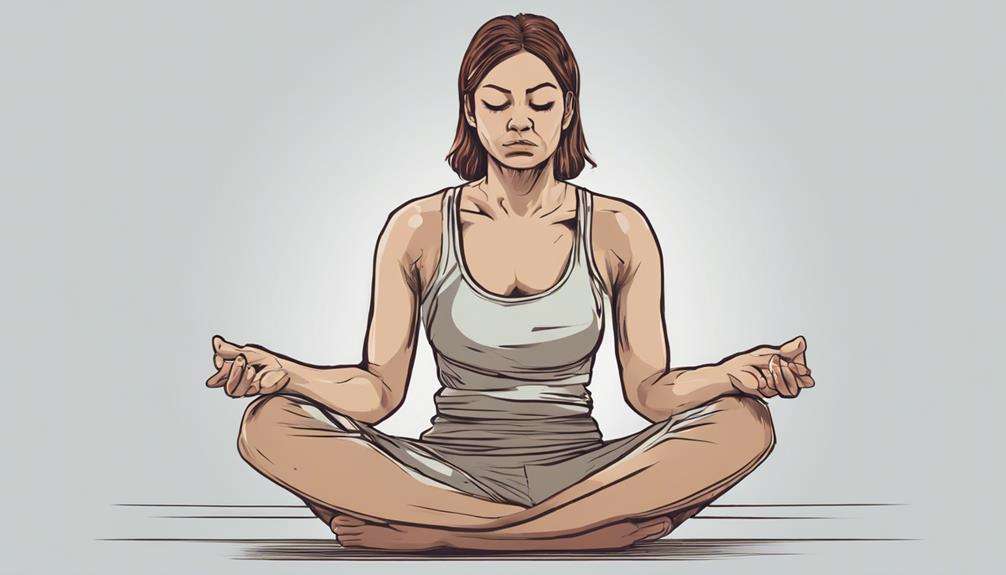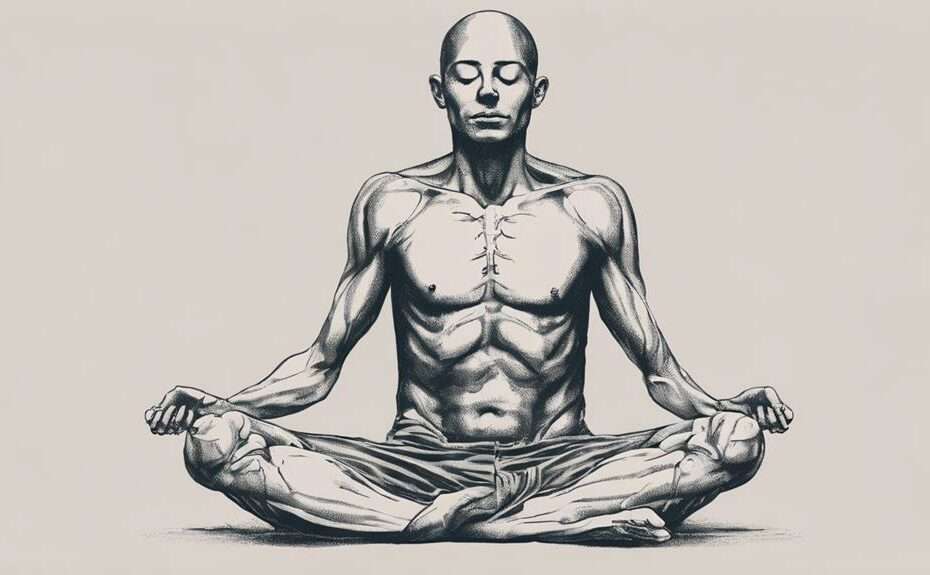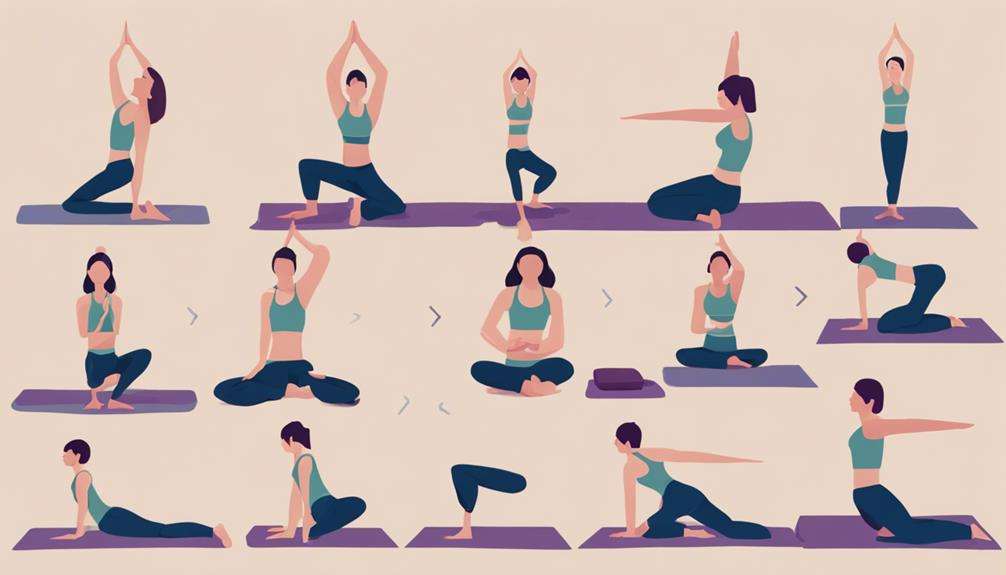Did you know that proper breathing techniques can improve your meditation practice greatly?
By mastering the 7 best practices for ideal breathing patterns during meditation, you can enhance your overall well-being and mindfulness.
From deep diaphragmatic breathing to specialized techniques like box breathing and Ujjayi Pranayama, each method offers unique benefits that can transform your meditation experience.
Discover how these practices can elevate your sense of calm and focus, leading to a more profound connection with yourself and the present moment.
Key Takeaways
- Proper breathing techniques optimize meditation and regulate the nervous system.
- Different breathing methods enhance focus, energy flow, and emotional stability.
- Balancing energy flow improves respiratory health, cognitive function, and emotional stability.
- Incorporating breathing practices daily enhances mindfulness, stress management, and overall well-being.
Understanding the Importance of Proper Breathing
Understanding the significance of proper breathing in meditation is essential for optimizing your practice and achieving profound relaxation and mental clarity. Breathing is a fundamental aspect of meditation, playing a pivotal role in regulating the nervous system and promoting overall well-being.
Deep, diaphragmatic breathing techniques are particularly beneficial as they enhance oxygen flow, reduce stress, alleviate anxiety, and improve mental clarity. By focusing on your breath during meditation, you can establish a sense of mindfulness, enhance your ability to concentrate, and cultivate emotional stability.
Consistent practice of proper breathing patterns can lead to a decrease in heart rate, blood pressure, and cortisol levels, contributing to a state of deep relaxation and inner peace. By incorporating correct breathing techniques into your meditation routine, you can deepen your practice, experience profound relaxation, and boost your overall mental and physical health.
Incorporating Diaphragmatic Breathing Techniques
Incorporating diaphragmatic breathing techniques involves engaging the diaphragm to facilitate deep inhalation and exhalation, promoting relaxation and reducing stress levels. This form of deep breathing is essential in meditation practices, as it enhances oxygen flow to the lungs, resulting in a calmer state of mind and body.
By incorporating diaphragmatic breathing into your daily routine, you can experience a decrease in heart rate, lower blood pressure, and an overall improvement in well-being. This technique not only helps reduce stress but also fosters mental clarity and emotional balance, making it a valuable tool for achieving inner peace.
Exploring the Benefits of Alternate Nostril Breathing

When you practice Alternate Nostril Breathing, you can experience benefits such as improved focus and mental clarity.
This technique helps balance the flow of energy in your body, promoting a sense of calm and relaxation.
Nostril Breathing Benefits
How does alternate nostril breathing benefit your brain's hemispheres and overall mental well-being during meditation practices?
Alternate Nostril Breathing, a powerful meditative breathing technique, offers numerous benefits for your mind and body. Here are some key advantages:
- Balances the left and right hemispheres of the brain.
- Reduces stress, anxiety, and promotes mental clarity.
- Enhances respiratory function, increasing oxygenation in the body.
Improved Focus and Clarity
Utilizing the technique of alternate nostril breathing, also known as Nadi Shodhana Pranayama, can greatly enhance your focus and mental clarity during meditation practices.
This method helps balance the brain's left and right hemispheres, leading to improved cognitive function, memory retention, and overall mental performance.
By regulating the flow of air through the nostrils, alternate nostril breathing stimulates the parasympathetic nervous system, reducing stress, anxiety, and blood pressure levels.
These physiological changes promote emotional stability, mindfulness enhancement, and attention sustainability.
Research indicates that incorporating this breathing technique into your meditation routine can support a sense of calmness and relaxation, contributing to a clearer mind and enhanced focus.
Balancing Energy Flow
Balancing the flow of energy in your body through the practice of Alternate Nostril Breathing, or Nadi Shodhana Pranayama, enhances oxygen intake and clears the nasal passages. By harnessing the power of this technique, you can experience a multitude of benefits that contribute to your overall well-being.
- Improved Oxygen Intake: Nadi Shodhana Pranayama guarantees ideal oxygen flow, crucial for various bodily functions.
- Enhanced Respiratory Functions: The practice supports healthy respiratory processes, aiding in overall lung health.
- Emotional Balance: By balancing energy flow, you can achieve emotional stability and inner harmony.
Incorporating Alternate Nostril Breathing into your meditation routine can significantly impact your cognitive performance, emotional balance, and physical health, paving the way for a more balanced and energized self.
Implementing Box Breathing for Relaxation

To enhance relaxation and promote mindfulness, consider implementing the technique of box breathing into your daily meditation routine. Box breathing, which involves inhaling, holding, exhaling, and holding the breath in equal counts, typically 4 seconds each, is known to promote relaxation by regulating the nervous system. By calming the mind and reducing stress levels, this practice can enhance focus and mindfulness when integrated into your daily meditation practices.
Prominently, box breathing is utilized by military personnel and athletes to manage anxiety, improve concentration, and enhance overall performance. Regular practice of box breathing can also lead to improvements in respiratory function, increasing oxygen levels in the body and contributing to overall well-being. By incorporating this technique into your meditation routine, you can experience the benefits of a calmer mind, reduced stress, enhanced focus, and improved respiratory health. Start by trying box breathing for a few minutes each day and gradually increase the duration as you become more comfortable with the practice.
Practicing Ujjayi Pranayama for Mindfulness
When progressing from implementing box breathing for relaxation, consider incorporating the practice of Ujjayi Pranayama, also known as Ocean Sounding Breath, into your meditation routine for enhanced mindfulness and relaxation. Ujjayi Pranayama is a breathing technique used in yoga and meditation to promote mindfulness and relaxation. By engaging in this practice, you can experience a deeper sense of inner peace and reduce stress effectively.
Here are some key benefits of practicing Ujjayi Pranayama:
- Enhanced Awareness: Ujjayi Pranayama helps regulate breathing patterns and increases your awareness of the breath, promoting a state of mindfulness.
- Improved Focus: The whispering sound created by constricting the throat during Ujjayi breathing serves as a natural anchor for concentration, enhancing focus during meditation.
- Stress Reduction: Incorporating Ujjayi Pranayama into your meditation practice can help calm the mind, reduce stress levels, and cultivate a sense of relaxation.
Harnessing the Power of Buteyko Breathing Technique

When exploring the Buteyko Breathing Technique, you'll discover its focus on reducing hyperventilation through nasal breathing and controlled breaths.
By emphasizing an ideal oxygen-carbon dioxide balance, this technique enhances respiratory efficiency and overall well-being.
Implementing Buteyko practices can lead to improved lung function, reduced respiratory symptoms, and a sense of relaxation and tranquility.
Buteyko Technique Benefits
Harnessing the power of the Buteyko breathing technique offers significant benefits by optimizing respiratory function and overall well-being through the promotion of shallow nasal breathing to enhance carbon dioxide levels in the body.
This technique can help reduce anxiety, improve respiratory function, and manage asthma symptoms effectively.
Additionally, by balancing the autonomic nervous system, increasing relaxation, and promoting slower breathing, the Buteyko method contributes to improved cardiovascular health. These combined effects lead to better control of breathing patterns and enhanced respiratory efficiency, ultimately supporting a healthier and more balanced respiratory system.
Practice of the Buteyko technique can bring about a range of positive impacts on both physical and mental well-being.
Implementing Buteyko Practices
Implement the Buteyko breathing technique by focusing on reducing breathing volume to enhance oxygenation and overall health. This technique, which includes nasal breathing, breath holds, and relaxation, helps reset the body's breathing pattern.
By practicing Buteyko breathing, you can find relief from conditions such as asthma, anxiety, sleep apnea, and stress. The emphasis on nasal breathing over mouth breathing in Buteyko practices optimizes carbon dioxide levels in the body. This optimization, along with improved lung function, enhances oxygen delivery and supports overall well-being through mindful breathing.
Incorporating Buteyko practices into your daily routine can have a positive impact on your respiratory health and mental well-being, making it a valuable addition to your breathing exercises and meditation practices.
Enhancing Breath Awareness Through Heart Rate Variability Biofeedback
Enhancing breath awareness through heart rate variability biofeedback allows you to gain real-time insights into the relationship between your breathing patterns and the variation in time intervals between heartbeats. This practice offers a unique way to connect with your body's physiological responses and improve mindfulness during meditation.
Here are some key benefits of incorporating heart rate variability biofeedback into your meditation routine:
- Understanding the balance between the sympathetic and parasympathetic nervous systems through heart rate variability feedback.
- Enhancing stress management and emotional regulation by improving vagal tone with controlled breathing techniques.
- Optimizing your physiological responses to reduce anxiety, enhance focus, and promote overall well-being.
Frequently Asked Questions
What Is the Best Breathing Method to Follow While Meditating?
For ideal breathing while meditating, focus on deep diaphragmatic breathing. Engage your belly to inhale deeply and exhale slowly. Incorporate alternate nostril and box breathing techniques for relaxation and improved focus. Enhance mindfulness with breath awareness and mindful breathing practices.
What Is the 4 7 8 Technique?
When practicing the 4-7-8 technique, you focus on deep, controlled breathing. It's a relaxation technique promoting stress reduction, a calm mind, and improved focus. Enhancing the mind-body connection, it serves as a sleep aid and provides anxiety relief.
What Is the Most Effective Breathing Pattern?
For best breathing during meditation, focus on slow, deep diaphragmatic breaths. Inhale slowly, exhale controlled, maintaining a consistent rhythm. This mindful practice engages your diaphragm, calms your mind, and promotes relaxation, enhancing your meditation experience.
What Are the Breathing Rules for Meditation?
Focus on breathing exercises such as diaphragmatic breathing, deep breathing, and mindful breathing. Maintain a consistent rhythm, balancing breaths, and counting breaths. Use techniques like alternate nostril, box breathing, ujjayi breath, and belly breathing for maximum meditation benefits.
Conclusion
To sum up, mastering ideal breathing patterns through meditation can improve your overall well-being.
Did you know that research has shown that deep diaphragmatic breathing can reduce cortisol levels by up to 50%?
By incorporating the 7 best practices outlined in this article, you can experience reduced stress, better sleep, enhanced immune function, and improved mental health.
Start incorporating these techniques into your daily routine to reap the benefits of mindful breathing.






